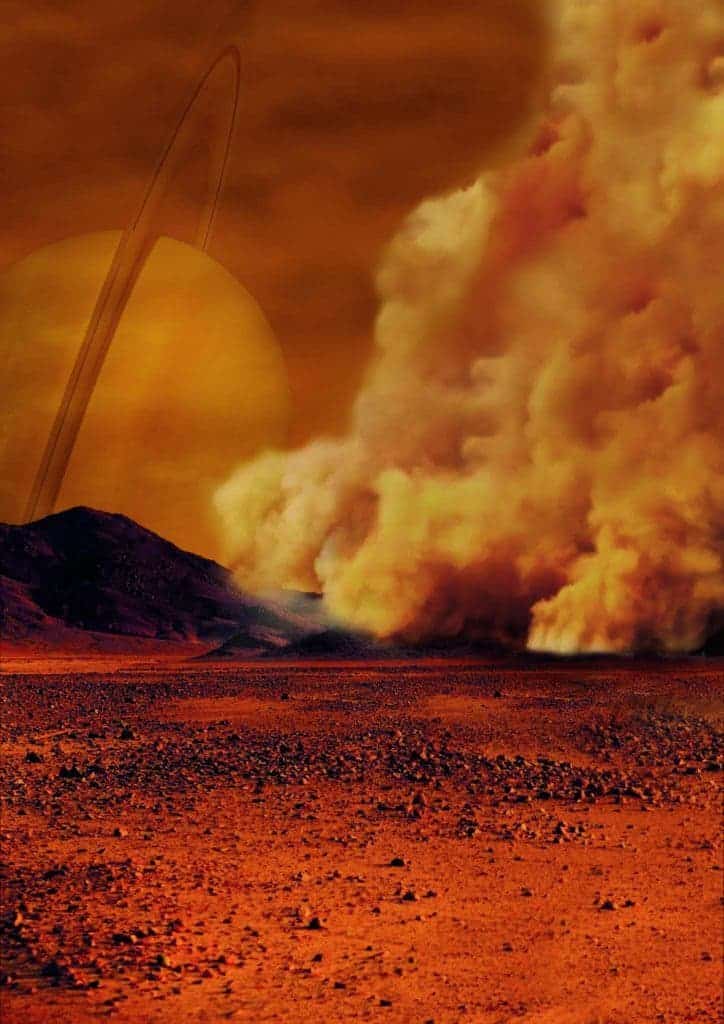
Saturn’s largest moon has long intrigued scientists as its chemical composition is believed to mirror that of our own primordial planet. Now, thanks to new data obtained by researchers by the University of Hawaii (UH) at Manoa, we might be able to provide some answers to key question’s about Titan’s surface.
The team, led by physical chemist Ralf I. Kaiser, examined remote sensing data from NASA’s Cassini-Huygens mission to Titan to study its huge swathes of desert which are covered in sand dunes. These dunes stretch across the moon’s equatorial region in a space over 10 million kilometers (6,213,712 miles) and reach heights of up to about 100 meters in some places — think Egyptian pyramids tall.
The UH Manoa team exposed acetylene ice — a chemical that is used on Earth in welding torches and exists at Titan’s equatorial regions — at low temperatures to proxies of high-energy galactic cosmic rays.
Titan’s dunes represent the dominating surface sink of carbon in Titan’s organic chemistry,” said Matthew Abplanalp, former chemistry graduate student at UH’s W.M. Keck Research Laboratory in Astrochemistry, and current researcher at the Naval Air Warfare Center Weapons Division at China Lake. “Therefore, unraveling the origin and chemical pathways to form this organic dune material is vital not only to understand Titan’s chemical evolution, but also to grasp how alike the chemistries on Titan and on Earth might have been like before life emerged on Earth 3.5 million years ago.”
The UH researchers exposed a rapid cosmic-ray-driven chemistry which converts simple molecules like acetylene to more complex organic molecules like benzene and naphthalene, a compound which is found in mothballs, but hopefully without the scent.
These findings will have unprecedented implications for the next space mission to Titan. In 2034, the three‐meters‐long Dragonfly rotorcraft will land in the ‘Shangri‐La’ dune‐fields near the moon’s equator. From there, it will use 1its eight rotors to traverse dozens of sites across Titan’s surface, taking samples and performing analysis. The purposes of the mission is to search for alien life and its molecular precursors.
“Overall, this study advances our understanding of the complex organics and fundamental chemical processing of simple molecules in deep space and provides a scientifically sound and proven mechanism of formation of aromatic structures in extreme environments in low temperature ices,” Kaiser concluded. “Since Titan is nitrogen-rich, the incorporation of nitrogen in these PAHs may also lead to carbon-nitrogen moieties (parts of a molecule) prevailing in contemporary biochemistry such as in DNA and RNA-based nitrogen-bases.”
Discovered in 1655 by the Dutchman Christiaan Huygens, Titan is located approximately 760,000 miles (1,223,101 kilometers) from Saturn. Cassini showed us that Titan’s surface has lakes, rivers, and even seas of liquid ethane and methane (the main component of natural gas), as well as vast expanses of sand dunes. Its climate is such that the methane can form clouds and even rain, as water does here on Earth. The moon’s atmosphere is four times denser than ours and its gravity is approximately 1/7th of Earth’s. Because it is so far from the Sun, Titan’s surface temperature hovers around a chilly ‐290 degrees Fahrenheit (‐179 degrees Celsius).


